
THE ROBERT VAN VORST SEWELL CHEST BY KARL VON RYDINGSVÄRD
White Oak, Wrought-iron fittings
25” high, 56”wide, 21 1/2 deep
Karl Arthur von Rydingsvärd (1863 – 1941) was a highly influential teacher who spread the very important ideal that everyone (even women!) could carve wood and turn it into useful household furnishings. He taught at Columbia: the Museum of Fine Arts, Boston; the Manchester Institute of Arts and Sciences; the Rhode Island School of Design; the Worcester Art Museum; the Troy School of Arts and Crafts, and the Massachusetts Normal Art School. Additionally he ran summer woodworking classes from his home near Brunswick, Maine; taught the Volk family how to carve at Hewnoaks, Maine; trained teachers to rehabilitate World War I veterans; and advised the New York Hospital about the role of craftwork in correcting nervous disorders and other mental dysfunctions.
Von Rydingsvärd began his career in America working with the Herter brothers and then with the esteemed A. H. Davenport Company. He ended his career and life (He died in a grass fire.) in Portland, Maine. Portland has sadly forgotten him: The Portland Museum of Art believes that decorative arts exhibitions do not draw crowds of sufficient size to warrant a von Rydingsvärd retrospective, which is contrary to my experience–– Charles Rohlfs made it all the way to the Metropolitan Museum of Art although politics may have been the determining factor in that instance.

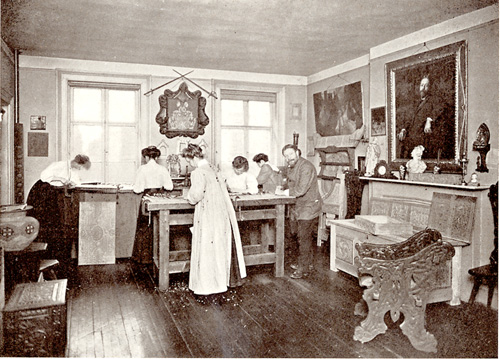 |
|
.A circa 1908 magazine illustration shows Karl von Rydingsvärd with female students. Chests and picture frames, such as those von Rydingsvärd was noted for, are visible as are several types of chairs.
|
A description of von Rydingsvärd woodwork is given in a 1905 New York Times article:
“They are usually of oak, and after being finished are given successive coats of oil. No varnish is used, and the natural grain of the wood is kept in sight as an important element in their beauty.”
The Sewell chest has an old layer of varnish over the original rich brown color, but the natural grain of the wood is still evident and beautiful.



THEODORE SWANN STOOL BY KARL VON RYDINGSVÄRD
White Oak, 19” high, 20 1⁄4” wide, 12 1⁄4” deep,
Original unvarnished polychrome finish Rohlfs. Stickley was thus elevated because he mass-marketed a version of the Arts and Crafts ideal; Rohlfs, because modern collectors value his unusual aesthetic. Von Rydingsvärd should be there not just for his distinctive aesthetic, but also because he was a highly influential teacher who spread the very important ideal that everyone (even women!) could carve wood and turn it into useful household furnishings. He taught at Columbia: the Museum of Fine Arts, Boston; the Manchester Institute of Arts and Sciences; the Rhode Island School of Design; the Worcester Art Museum; the Troy School of Arts and Crafts, and the Massachusetts Normal Art School. Additionally he ran summer woodworking classes from his summer home in Brunswick, Maine; taught the Volk family how to carve at Hewnoaks, trained teachers to rehabilitate World War I veterans, and advised the New York Hospital about the role of craftwork in correcting nervous disorders and other mental dysfunctions.
Von Rydingsvärd began his career in America working with the Herter brothers and then with the esteemed A. H. Davenport Company. He ended his career and life (He died in a grass fire.) in Portland, Maine. Portland has sadly forgotten him: The Portland Museum of Art believes that decorative arts exhibitions do not draw crowds of sufficient size to warrant a von Rydingsvärd retrospective, which is contrary to my experience–– Charles Rohlfs made it all the way to the Metropolitan Museum of Art although politics may have been the determining factor in that instance.
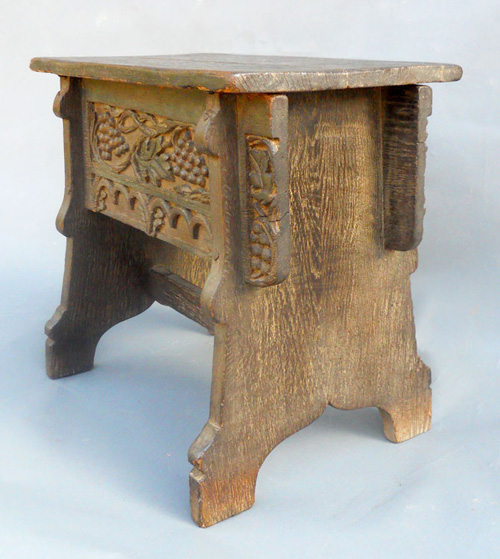
This stool was part of a large commission for the Theodore Swann house, which still stands (now called the Swann/Coleman house) in Birmingham, Alabama. The carving relates to decorations on the Swann exterior and the vine and berry motif used on the suite of furniture designed for the great hall, as well as to the carving on exterior of Florence and William Sloane’s “Hermitage” in Norfolk, Virginia. The rusticated polychrome finish matches a description of von Rydingsvärd woodwork from a 1905 New York Times article:
“They are usually of oak, and after being finished are given successive coats of oil. No varnish is used, and the natural grain of the wood is kept in sight as an important element in their beauty.”
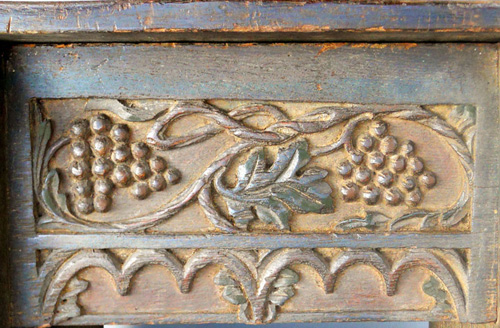

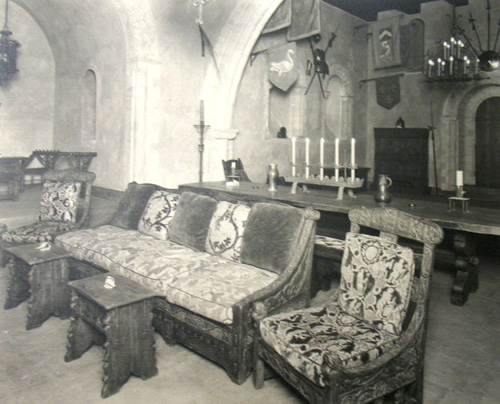

.
.

A RARE AND FINE KARL von RYDINGSVÄRD PICTURE FRAME
American quartered oak, outside edge of frame: 19" x 15"
Signed on face of frame: “K. v. R.”
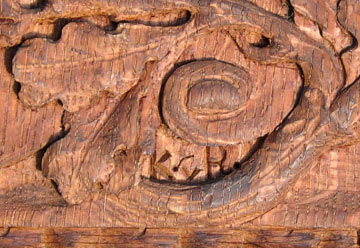
This frame is a superb example of the work of an important avatar of the American Arts and Crafts movement. Much of von Rydingsvärd’s work took inspiration from ancient Norse art, but this frame has direct links to the movement in the United States. Carved from indigenous wood, the oak leaves and acorns were motifs favored by Eastern arts and craftsmen, which included the Volk family for whom this frame was carved--they called their Maine home “Hewnoaks.” The same shallow volutes appear on frames made by von Rydingsvärd student Wendell Volk, although their use here in an asymmetrical composition is more sophisticated.
Since the frame was made to hang out of harm’s way, it was not subjected to the wear and tear usually found on pieces of antique furniture. The carving on the unvarnished oak remains as crisp and fresh as it was when the artist’s chisel last touched the wood’s surface.

“Aunt Fanny” oil paint on canvas, 12" x 9" wide, signed lower right: “D. Volk”
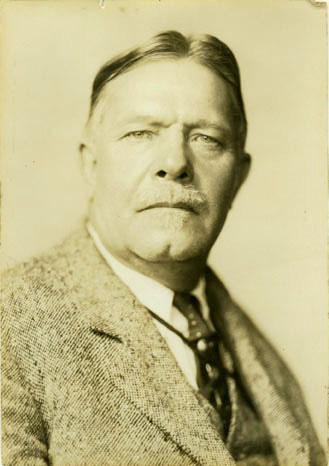
Karl Arthur von Rydingsvärd was born in 1863 (one genealogy gives 1862) into the Swedish aristocracy. He received training as a “decorative sculptor” at the Royal Technical School, Stockholm, before arriving in the United States in 1883. His first home was in Boston, Massachusetts, where he established a school of art woodcarving. He married Anna M. Davis, whom he met at the Massachusetts Normal Art School. He was divorced from Anna in 1897.
While living in Massachusetts, Karl taught at the Rhode Island School of Design and the Institute of Arts and Sciences in Manchester, New Hampshire. He then set up a studio in New York City where he taught “many well-known society women.” He was director of art and craft training at Teacher’s College at Columbia University. He directed the Troy School of Arts and Crafts and trained teachers in Los Angeles, who were to rehabilitate soldiers wounded in World War I. He ran a summer school in Brunswick, Maine, where he built a house, which still exists. He served in an advisory capacity with the New York Hospital aiding in the correction of nervous disorders and mental cases.
von Rydingsvärd won a silver medal at the 1892 World’s Columbian Exposition in Chicago. In 1913 he won the $1,000 prize from the Arts Club of the National Society of Craftsmen of which he was a member, vice president, and director. He was also a member of the Architectural League of New York, the National Arts Club, and the Art Associates of Portland (Maine). He was a contributor to crafts publications, including Gustav Stickley’s The Craftsman. His work appeared in many art publications including International Studio, Arts and Decoration, and American Homes and Gardens.
Karl and his second wife Ida moved to a house he built in Portland, Maine, in 1920. He died in 1941 from burns suffered while fighting a grass fire at his home.
Provenance:
2006: Purchased from “Hewnoaks,” the estate of Jessie Volk.
“Hewnoaks” was the rustic Tudor cottage built on the shores of Kezar Lake in Lovell, Maine, by the Douglas Volk family of artists. Douglas Volk was the son of Leonard Volk, who is famous for his many life casts of Abraham Lincoln. Douglas studied in Paris and Italy. He taught at the Cooper Union, the Art Students League, and the National Academy of Design in New York and was a founder of the Minneapolis School of Fine Art. He participated in the 1893 Chicago Columbian Exposition and taught at the New York Society for Ethical Culture established by Felix Adler, where he met Karl von Rydingsvärd. He married Marion Larabee in 1881 and they had two children, Marion and Wendell. Daughter Marion helped Mother Marion run the Sabatos Studio, which produced woven and printed textiles. Wendell was also a weaver and learned woodcarving from Karl von Rydingsvärd. Wendell’s wife Jessie left Hewnoaks, lock, stock, and barrel, to the University of Maine.
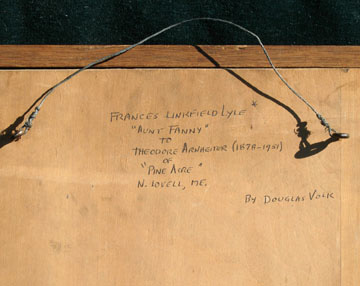 |
Note:
It is not known if this frame was made specifically for the painting now within it. A ballpoint ink inscription on the hinged wooden backing suggests that the two artworks have been together since 1951 at least: /“Fancis Linkfield Lyle”/ “’Aunt Fanny’”/ “To”/ “Theodore Arrnheiter (1878-1951)”/ “of”/ “N. Lovell, Me.”/ “By Douglas Volk”/. |
..
KARL VON RYDINGSVÄRD NORSE FIREPLACE MANTLE
Oak: 59 inches wide by 45 3/8” high (outside)
Karl Arthur von Rydingsvärd (1863 – 1941) was not only an important artisan during the Arts and Crafts movement in America; he was also a highly influential teacher who spread the essential Arts and Crafts ideal that anyone (even women!) could carve wood and turn it into useful household furnishings. He taught at Columbia: the Museum of Fine Arts, Boston; the Manchester Institute of Arts and Sciences; the Rhode Island School of Design; the Worcester Art Museum; the Troy School of Arts and Crafts, and the Massachusetts Normal Art School. Additionally he ran summer woodworking classes from his home near Brunswick, Maine; taught the Volk family how to carve at Hewnoaks, Maine; trained teachers to rehabilitate World War I veterans; and advised the New York Hospital about the role of craftwork in correcting nervous disorders and other mental dysfunctions.
Von Rydingsvärd began his career in America working with the Herter brothers and then with the esteemed A. H. Davenport Company. He ended his career and life (He died in a grass fire.) in Portland, Maine.
This mantle was found on Long Island near the home of von Rydingsvärd’s friend artist Robert Van Vorst Sewell (1860-1924). Sewell—a von Rydingsvärd student—carved many of the decorations on and in his home and studio, but he was also a collector of von Rydingsvärd’s woodcarvings. The carving on the mantle relates to decorations on a chest owned by Sewell. A catalogue for the 1904 Louisiana Purchase Exposition in St. Louis lists a von Rydingsvärd chair belonging to Sewell as being in the United States exhibit of applied arts. Both Sewell and von Rydingsvärd spent summers in Maine. A description of von Rydingsvärd woodwork is given in


Similar two-headed birds appear on both the Mantle (detail above)
and the Sewell chest (detail below)

The mantle retains its original rich brown color; it has never been varnished so the natural grain of the wood is still evident and beautiful.
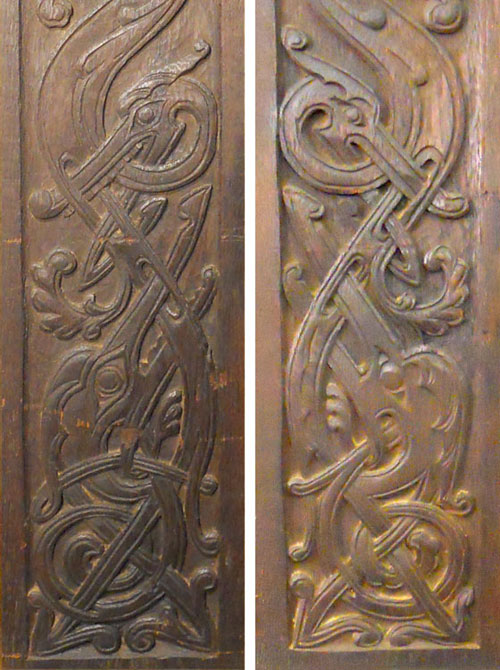
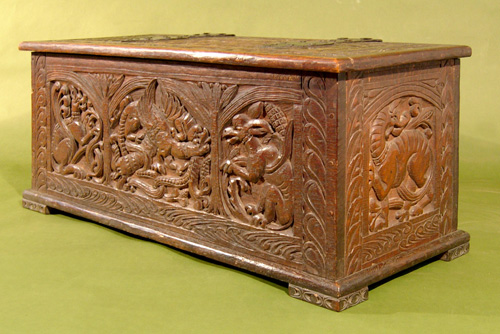
Oak Chest 36” X 16” X 15.5” Carved by Ida von Rydingsvärd in 1901
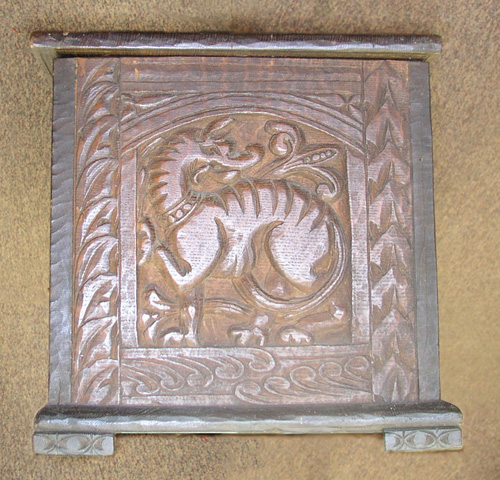

Walnut Desk 26” X 13” X 28” and chair, ca 1910,
commercially made, later carving attributed to Wendell Volk

|